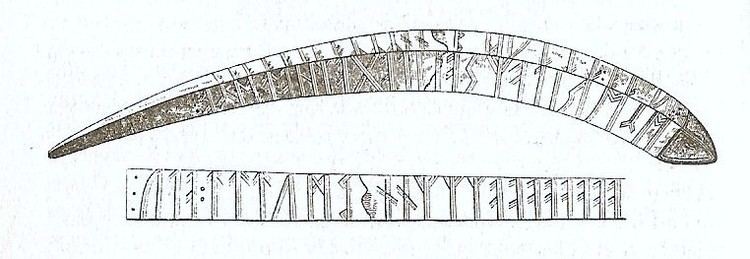 | ||
The Lindholm "amulet", listed as DR 261 in Rundata, is a bone piece, carved into the shape of a rib, dated to the 2nd to 4th centuries (the late Roman Iron Age) and has a runic inscription.
It was found in 1840 in Skåne, Sweden, while cutting peat from a bog. This cut the bone in half and resulted in the destruction of one rune in the second line of text.
The inscription reads
ᛖᚲᛖᚱᛁᛚᚨᛉᛋᚨ[ᚹ]ᛁᛚᚨᚷᚨᛉᚺᚨᛏᛖᚲᚨ᛬ᚨᚨᚨᚨᚨᚨᚨᚨᛉᛉᛉᚾᚾ[ᚾ]ᛒᛗᚢᛏᛏᛏ᛬ᚨᛚᚢ᛬ekerilazsa[w]ilagazhateka:aaaaaaaazzznn[n]bmuttt:alu:The first line is transcribed into Proto-Norse as either Ek erilaz sa Wilagaz haite'ka or Ek erilaz Sawilagaz haite'ka. This translates to "I am (an) erilaz, I am called the wily" (or "I am called Sawilagaz). If the word in first line is translated as a name, Sawilagaz means "the one of the Sun (Sowilo)." If the word is translated as "the wily" or "crafty one" or "deceitful one," then it may be related to a byname of Odin or another god.
The sequence in the second line contains a "magical" string of runes concluding in alu. The three consecutive Tiwaz runes as an invocation of the god Tiwaz, and the eight Ansuz runes as an invocation or symbolic list of eight gods.
